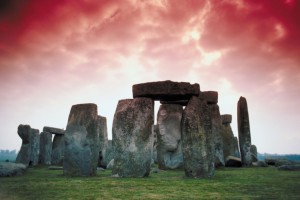 Stonehenge is a prehistoric monument located in Wiltshire, England, approximately 20 minutes north of Salisbury and two hours west of London. It consists of the remains of a circle of gigantic standing stones, and is one of the most well-known historic sites in the world. Stonehenge has fascinated and confounded historians and visitors alike for centuries. Approximately 1,000,000 people visit the monument each year and it is the most popular English heritage site.
Stonehenge is a prehistoric monument located in Wiltshire, England, approximately 20 minutes north of Salisbury and two hours west of London. It consists of the remains of a circle of gigantic standing stones, and is one of the most well-known historic sites in the world. Stonehenge has fascinated and confounded historians and visitors alike for centuries. Approximately 1,000,000 people visit the monument each year and it is the most popular English heritage site.
History
According to archeologists, Stonehenge was built sometime between 3000 and 2000 B.C. This construction time-frame was established using radio carbon dating. Some believe it is an ancient place of worship and burial ground. The cremated remains found on the site help support this theory. The sheer size and weight of the stones makes it difficult to identify a way they were transported to the area by humans during the widely accepted 3000–2000 B.C. construction period. No viable alternative existed until much later in human history. As a result, numerous people have proposed supernatural forces moved them to the location.
Who Built Stonehenge?
There has been much speculation about who built Stonehenge with some of the theories much more plausible than others. Here are a few:
- Indigenous tribes
- Aliens
- Druids
- Greeks
- Phoenicians
- The people of Atlantis
- Merlin, King Arthur’s legendary wizard
Pagan Worship
Paganism is a religious tradition based on veneration for nature. In the 2011 United Kingdom census, close to 57,000 residents of England and Wales classified themselves as Pagans. Pagan rituals take place at Stonehenge each year. One of the best attended is the summer solstice celebration which occurs in the northern hemisphere every year from June 20–22. It marks the beginning of summer and is the longest day of the year. The sun reaches its maximum elevation on the summer solstice. For millenniums, the date has been spiritually significant as mankind has always been in awe of the power of the sun. Stonehenge is constructed on the line of the midsummer sunrise and sunset which indicates to many archaeologists and historians it was built to mark the solstice. Thousands of pagans and non-pagans travel to Stonehenge each year to witness the sun rise on the morning of the summer solstice.
Ownership
Stonehenge has an interesting list of owners and has been under private control since the Middle Ages. Some of the people who have owned the monument include:
- Duke of Somerset, Sir Edward Seymour – gifted to the Duke by King Henry VIII in 1540
- Robert Newdyk – purchased in approximately 1614
- Sir Lawrence Washington (ancestor of U.S. President George Washington) – purchased in approximately 1628
- Reverend Thomas Hayward – purchased in approximately 1678 and held a fair on the grounds
- Earls of Ayesbury
- Lord Carleton – purchased in approximately 1720
- Antrobus family – purchased in approximately 1824. The family sold the stones at auction in 1915 when the only son and family heir was killed in WWI.
- Cecil Chubb – purchased at auction in 1915.
Chubb grew up four miles from Stonehenge and reportedly bought the stones for his wife on a whim. He felt someone local should own them and not a foreigner who may decide to relocate them overseas. Stonehenge and the surrounding 30 acres were sold to Chubb for 6,600 British pounds sterling, which is the equivalent of $623,000 today. Stonehenge is currently valued at over $751,000,000. Chubb ultimately felt the monument belonged to the people of the United Kingdom and officially handed it over to the government in 1918. One of his conditions was local residents always be given free access.
After centuries of research, contemplation and speculation, Stonehenge remains an enigma. No matter your convictions on the history of this spectacular monument, it is well worth the trip to see it in person.

